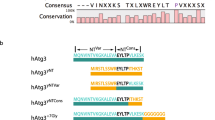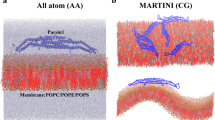Abstract
The Golgi-associated protein ArfGAP1 has an unusual membrane-adsorbing amphipathic α-helix: its polar face is weakly charged, containing mainly serine and threonine residues. We show that this feature explains the specificity of ArfGAP1 for curved versus flat lipid membranes. We built an algorithm to identify other potential amphipathic α-helices rich in serine and threonine residues in protein databases. Among the identified sequences, we show that three act as membrane curvature sensors. In the golgin GMAP-210, the sensor may serve to trap small vesicles at the end of a long coiled coil. In Osh4p/Kes1p, which transports sterol between membranes, the sensor controls access to the sterol-binding pocket. In the nucleoporin Nup133, the sensor corresponds to an exposed loop of a β-propeller structure. Ser/Thr-rich amphipathic helices thus define a general motif used by proteins of various functions for sensing membrane curvature.
This is a preview of subscription content, access via your institution
Access options
Subscribe to this journal
Receive 12 print issues and online access
$189.00 per year
only $15.75 per issue
Buy this article
- Purchase on Springer Link
- Instant access to full article PDF
Prices may be subject to local taxes which are calculated during checkout






Similar content being viewed by others

References
Dunne, S.J., Cornell, R.B., Johnson, J.E., Glover, N.R. & Tracey, A.S. Structure of the membrane binding domain of CTP:phosphocholine cytidylyltransferase. Biochemistry 35, 11975–11984 (1996).
Antonny, B., Beraud-Dufour, S., Chardin, P. & Chabre, M. N-terminal hydrophobic residues of the G-protein ADP-ribosylation factor-1 insert into membrane phospholipids upon GDP to GTP exchange. Biochemistry 36, 4675–4684 (1997).
Jao, C.C., Der-Sarkissian, A., Chen, J. & Langen, R. Structure of membrane-bound alpha-synuclein studied by site-directed spin labeling. Proc. Natl. Acad. Sci. USA 101, 8331–8336 (2004).
Dathe, M. & Wieprecht, T. Structural features of helical antimicrobial peptides: their potential to modulate activity on model membranes and biological cells. Biochim. Biophys. Acta 1462, 71–87 (1999).
Lee, M.C. et al. Sar1p N-terminal helix initiates membrane curvature and completes the fission of a COPII vesicle. Cell 122, 605–617 (2005).
Ford, M.G. et al. Curvature of clathrin-coated pits driven by epsin. Nature 419, 361–366 (2002).
Farsad, K. et al. Generation of high curvature membranes mediated by direct endophilin bilayer interactions. J. Cell Biol. 155, 193–200 (2001).
Hristova, K. et al. An amphipathic alpha-helix at a membrane interface: a structural study using a novel X-ray diffraction method. J. Mol. Biol. 290, 99–117 (1999).
Bigay, J., Casella, J.F., Drin, G., Mesmin, B. & Antonny, B. ArfGAP1 responds to membrane curvature through the folding of a lipid packing sensor motif. EMBO J. 24, 2244–2253 (2005).
McMahon, H.T. & Mills, I.G. COP and clathrin-coated vesicle budding: different pathways, common approaches. Curr. Opin. Cell Biol. 16, 379–391 (2004).
Tanigawa, G. et al. Hydrolysis of bound GTP by ARF protein triggers uncoating of Golgi-derived COP-coated vesicles. J. Cell Biol. 123, 1365–1371 (1993).
Bigay, J., Gounon, P., Robineau, S. & Antonny, B. Lipid packing sensed by ArfGAP1 couples COPI coat disassembly to membrane bilayer curvature. Nature 426, 563–566 (2003).
Antonny, B., Huber, I., Paris, S., Chabre, M. & Cassel, D. Activation of ADP-ribosylation factor 1 GTPase-activating protein by phosphatidylcholine-derived diacylglycerols. J. Biol. Chem. 272, 30848–30851 (1997).
Parnis, A. et al. Golgi localization determinants in ArfGAP1 and in new tissue-specific ArfGAP1 isoforms. J. Biol. Chem. 281, 3785–3792 (2006).
Antonny, B. Membrane deformation by protein coats. Curr. Opin. Cell Biol. 18, 386–394 (2006).
Infante, C., Ramos-Morales, F., Fedriani, C., Bornens, M. & Rios, R.M. GMAP-210, A cis-Golgi network-associated protein, is a minus end microtubule-binding protein. J. Cell Biol. 145, 83–98 (1999).
Raychaudhuri, S., Im, Y.J., Hurley, J.H. & Prinz, W.A. Nonvesicular sterol movement from plasma membrane to ER requires oxysterol-binding protein-related proteins and phosphoinositides. J. Cell Biol. 173, 107–119 (2006).
Berke, I.C., Boehmer, T., Blobel, G. & Schwartz, T.U. Structural and functional analysis of Nup133 domains reveals modular building blocks of the nuclear pore complex. J. Cell Biol. 167, 591–597 (2004).
Mishra, V.K. & Palgunachari, M.N. Interaction of model class A1, class A2, and class Y amphipathic helical peptides with membranes. Biochemistry 35, 11210–11220 (1996).
Mishra, V.K., Palgunachari, M.N., Segrest, J.P. & Anantharamaiah, G.M. Interactions of synthetic peptide analogs of the class A amphipathic helix with lipids. Evidence for the snorkel hypothesis. J. Biol. Chem. 269, 7185–7191 (1994).
Bigay, J. & Antonny, B. Real-time assays for the assembly-disassembly cycle of COP coats on liposomes of defined size. Methods Enzymol. 404, 95–107 (2005).
Murray, D. et al. Electrostatic properties of membranes containing acidic lipids and adsorbed basic peptides: theory and experiment. Biophys. J. 77, 3176–3188 (1999).
Seelig, J. Thermodynamics of lipid-peptide interactions. Biochim. Biophys.Acta 1666, 40–50 (2004).
Sapay, N., Guermeur, Y. & Deleage, G. Prediction of amphipathic in-plane membrane anchors in monotopic proteins using a SVM classifier. BMC Bioinformatics 7, 255 (2006).
Eisenberg, D., Weiss, R.M. & Terwilliger, T.C. The helical hydrophobic moment: a measure of the amphiphilicity of a helix. Nature 299, 371–374 (1982).
Mesmin, B. et al. Two lipid packing sensor motifs contribute to the sensitivity of ArfGAP1 to membrane curvature. Biochemistry (in the press).
Barr, F.A. & Short, B. Golgins in the structure and dynamics of the Golgi apparatus. Curr. Opin. Cell Biol. 15, 405–413 (2003).
Rios, R.M., Sanchis, A., Tassin, A.M., Fedriani, C. & Bornens, M. GMAP-210 recruits gamma-tubulin complexes to cis-Golgi membranes and is required for Golgi ribbon formation. Cell 118, 323–335 (2004).
Gillingham, A.K., Tong, A.H., Boone, C. & Munro, S. The GTPase Arf1p and the ER to Golgi cargo receptor Erv14p cooperate to recruit the golgin Rud3p to the cis-Golgi. J. Cell Biol. 167, 281–292 (2004).
Im, Y.J., Raychaudhuri, S., Prinz, W.A. & Hurley, J.H. Structural mechanism for sterol sensing and transport by OSBP-related proteins. Nature 437, 154–158 (2005).
Belgareh, N. et al. An evolutionarily conserved NPC subcomplex, which redistributes in part to kinetochores in mammalian cells. J. Cell Biol. 154, 1147–1160 (2001).
White, S.H. & Wimley, W.C. Hydrophobic interactions of peptides with membrane interfaces. Biochim. Biophys. Acta 1376, 339–352 (1998).
Gallop, J.L. et al. Mechanism of endophilin N-BAR domain-mediated membrane curvature. EMBO J. 25, 2898–2910 (2006).
Masuda, M. et al. Endophilin BAR domain drives membrane curvature by two newly identified structure-based mechanisms. EMBO J. 25, 2889–2897 (2006).
Michelitsch, M.D. & Weissman, J.S. A census of glutamine/asparagine-rich regions: implications for their conserved function and the prediction of novel prions. Proc. Natl. Acad. Sci. USA 97, 11910–11915 (2000).
Choma, C., Gratkowski, H., Lear, J.D. & DeGrado, W.F. Asparagine-mediated self-association of a model transmembrane helix. Nat. Struct. Biol. 7, 161–166 (2000).
Zhou, F.X., Cocco, M.J., Russ, W.P., Brunger, A.T. & Engelman, D.M. Interhelical hydrogen bonding drives strong interactions in membrane proteins. Nat. Struct. Biol. 7, 154–160 (2000).
Rios, R.M. et al. A peripheral protein associated with the cis-Golgi network redistributes in the intermediate compartment upon brefeldin A treatment. J. Cell Biol. 125, 997–1013 (1994).
Pernet-Gallay, K. et al. The overexpression of GMAP-210 blocks anterograde and retrograde transport between the ER and the Golgi apparatus. Traffic 3, 822–832 (2002).
Lehto, M. & Olkkonen, V.M. The OSBP-related proteins: a novel protein family involved in vesicle transport, cellular lipid metabolism, and cell signalling. Biochim. Biophys. Acta 1631, 1–11 (2003).
Fang, M. et al. Kes1p shares homology with human oxysterol binding protein and participates in a novel regulatory pathway for yeast Golgi-derived transport vesicle biogenesis. EMBO J. 15, 6447–6459 (1996).
Li, X. et al. Analysis of oxysterol binding protein homologue Kes1p function in regulation of Sec14p-dependent protein transport from the yeast Golgi complex. J. Cell Biol. 157, 63–77 (2002).
Yanagisawa, L.L. et al. Activity of specific lipid-regulated ADP ribosylation factor-GTPase-activating proteins is required for Sec14p-dependent Golgi secretory function in yeast. Mol. Biol. Cell 13, 2193–2206 (2002).
Walther, T.C. et al. The conserved Nup107–160 complex is critical for nuclear pore complex assembly. Cell 113, 195–206 (2003).
Harel, A. et al. Removal of a single pore subcomplex results in vertebrate nuclei devoid of nuclear pores. Mol. Cell 11, 853–864 (2003).
Bremser, M. et al. Coupling of coat assembly and vesicle budding to packaging of putative cargo receptors. Cell 96, 495–506 (1999).
Sreerama, N. & Woody, R.W. Estimation of protein secondary structure from circular dichroism spectra: comparison of CONTIN, SELCON, and CDSSTR methods with an expanded reference set. Anal. Biochem. 287, 252–260 (2000).
Fauchere, J. & Pliska, V. Hydrophobic parameters π of amino-acid side chains from the partitioning of N-acetyl-amino-acid amides. Eur. J. Med. Chem. 8, 369–375 (1983).
Acknowledgements
We thank M. Bornens (Institut Curie), R.M. Rios (Universidad de Sevilla) and V.A. Bankaitis (University of North Carolina) for the GMAP-210 and Kes1p plasmids, S. Scarzello for mass spectrometry analysis, N. Leroudier for DNA sequencing and V. Morello for help with experiments. We also thank M. Bornens, M. Chabre, B. Goud, C. Jackson, S. Paris and members of our laboratories for discussions. This work was supported by the CNRS, the Ministère de la Recherche (Action Concertée Incitative: dynamique et réactivité des assemblages biologiques) and by the Agence Nationale de la Recherche (ANR non thématique). G.D. was supported by postdoctoral fellowships from the CNRS and the ANR.
Author information
Authors and Affiliations
Contributions
G.D. and B.A. conceived the study and wrote the manuscript. G.D. and J.-F.C. prepared most protein constructs and performed the biochemical experiments. G.D. performed the spectroscopic measurements. R.G. conceived the bioinformatics program. T.B. and T.U.S. designed and prepared the Nup133 constructs.
Corresponding author
Ethics declarations
Competing interests
The authors declare no competing financial interests.
Supplementary information
Supplementary Table 1
Human proteins with a putative ALPS-like motif. (PDF 231 kb)
Supplementary Table 2
Yeast proteins with a putative ALPS-like motif. (PDF 217 kb)
Rights and permissions
About this article
Cite this article
Drin, G., Casella, JF., Gautier, R. et al. A general amphipathic α-helical motif for sensing membrane curvature. Nat Struct Mol Biol 14, 138–146 (2007). https://doi.org/10.1038/nsmb1194
Received:
Accepted:
Published:
Issue Date:
DOI: https://doi.org/10.1038/nsmb1194
This article is cited by
-
Lipid saturation controls nuclear envelope function
Nature Cell Biology (2023)
-
The Functionality of Membrane-Inserting Proteins and Peptides: Curvature Sensing, Generation, and Pore Formation
The Journal of Membrane Biology (2023)
-
Grease in the Nucleus: Insights into the Dynamic Life of Nuclear Membranes
The Journal of Membrane Biology (2023)
-
Curvature dependence of BAR protein membrane association and dissociation kinetics
Scientific Reports (2022)
-
Insights into Membrane Curvature Sensing and Membrane Remodeling by Intrinsically Disordered Proteins and Protein Regions
The Journal of Membrane Biology (2022)


